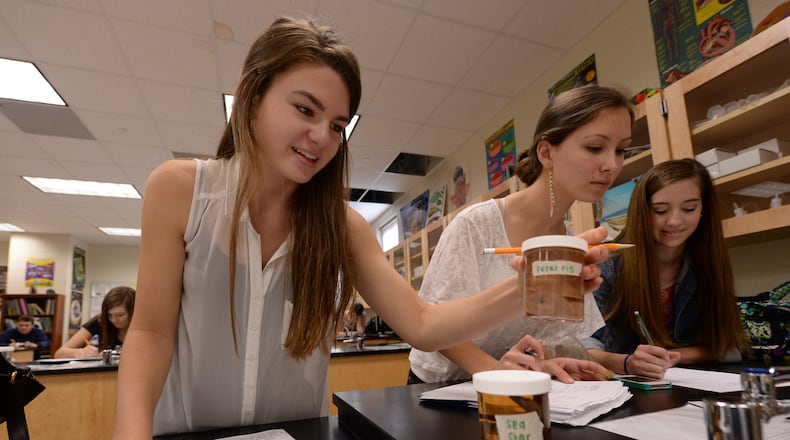A closer look at metro high schools
The Georgia Department of Education released a new report card tool this week that grades a school’s performance on a scale of 0 to 100. A school can earn 10 bonus points for a possible score of 110. This grading system replaces the “Adequate Yearly Progress (AYP)” designation, which was criticized because it only rated schools as pass or fail. Here’s a look at the top performance scores among metro Atlanta high schools:
School district/School/Score
Gwinnett/Gwinnett School of Mathematics, Science and Technology/99.8
Atlanta/Early College High School at Carver/96.3
DeKalb/DeKalb School of the Arts/95.5
DeKalb/DeKalb Early College Academy/95.2
Forsyth/Lambert High School/94.6
Cobb/Lassiter High School/94.4
Cobb/Walton High School/94.4
Cobb/Pope High School/94.1
Forsyth/South Forsyth High School/93.9
Cobb/Harrison High School/93.9
Source: Georgia Department of Education
Lambert High School principal Gary Davison
Principal, Lambert High, 2008-Present
Principal, South Forsyth High, 2006-2008
Principal, Settle Bridge Elementary, 2003-2006
Assistant principal, Settle Bridge Elementary, 2002-2003
Assistant principal, Lakeside High, 2000-2002
Assistant principal, Dunwoody High, 1999-2000
Assistant principal, Bernard Elementary (St. Louis), 1998-1999
Sixth-grade teacher, Forder Elementary (St. Louis), 1991-1998
Source: Gary Davison’s resume
Lambert High School in Forsyth County is the top traditional public high school in metro Atlanta, according to the state’s newest measuring stick, but its principal calls it an “un-high school.”
The school of 2,353 students succeeds, principal Gary Davison says, because it has enhanced communication among students, teachers and parents while also offering a rigorous curriculum including 26 advanced placement classes.
It actually shares a lot of traits with the other traditional high schools in metro Atlanta that did best on Georgia’s new report card: South Forsyth High and Cobb County’s Harrison, Lassiter, Pope and Walton high schools. They all pull students from affluent, mostly white areas with highly involved parents and academically competitive students.
Coming Sunday: A school's success with the former grading system is no guarantee in the new rankings.
But Davison said his school’s version of education reform can be replicated in less well-off schools.
“If we don’t have a relationship built, kids are going to throw their hands up in the air and say: ‘Forget it. I’m done.’ But if they have a strong emotional connection, they’re going to do the work,” Davison said. “It’s not rocket science. There’s no secret sauce.”
Located in a county with a median household income of about $82,000, the 4-year-old school 18 miles north of the Perimeter scored well in large part because of its graduation rate and performance on End-of-Course Tests. The state’s new College and Career Ready Performance Index is more detailed than its predecessor, which showed whether schools were making adequate yearly progress under the federal No Child Left Behind Act. Lambert also did well on the AYP, passing in all the necessary categories on the most recent test.
Under the new index, Lambert had the highest achievement score and graduation rate (97.49 percent in 2011) of any traditional public high school in the Atlanta area. The only schools that did better were four smaller charter, magnet and early college schools.
Failure is not an option in a world in which a high school diploma or GED is the bare minimum requirement needed for many jobs, Davison said.
“We can’t hold the same approach we always saw in the past,” he said. “Historically, high schools have been looked at as a factory or an institution, and I don’t want to be seen that way. If you look at a school as an institution that way, you’re losing the individual person. That’s what I mean by an un-high school.”
Nearby schools that also scored well on the state report card, such as Lassiter, use a similar formula. Lassiter offers 21 AP classes, frequently communicates with parents and schedules a three-days-a-week class for academic support and enrichment, principal Chris Richie said.
“The kids are proud to go to Lassiter High School, and that enthusiasm extends to their classes,” Richie said. “It helps when you have an extremely motivated parent base.”
Lambert is on the right track because it combines quality teachers, a strong leader and a constructive culture, said Dana Rickman, the policy and research director for the Georgia Partnership for Excellence in Education. A growing body of research indicates that school culture makes a difference, she said.
“When you have a school that’s able to embrace a collaborative, warm and supportive student culture, you’re able to get better student outcomes,” Rickman said. “But it takes a long time, and you have to have a lot of trust and expertise.”
Rickman said schools in wealthier areas tend to have built-in advantages such as more involved parents and greater resources to raise money for school needs.
“In low-income districts, parents are working multiple jobs and have less time to invest in the school. That makes it more difficult,” she said. “The community involvement tends to be a little more apparent in affluent areas.”
A big part of the Lambert culture involves heaping positive reinforcement on students.
The names of students who score at the highest levels on AP exams are engraved on plaques that line the school’s hallways. Signs bragging of six state athletic championships for the Longhorns line the road leading to the school.
But struggling students also get plenty of attention, with teachers offering assistance, not discipline.
“They’re always here for you, even beyond academics,” senior Caroline Lamb said of the school’s teachers.
Although it’s a large school, Lambert’s educators keep track of every student. Near the end of each grading period, Davison looks up students who are in danger of failing and their teachers to try to find trends.
Content data teams of teachers review student performance and curriculums. Counselors provide aid with academics, college selection and career readiness.
Parents said they appreciate the academic rigor and close connections to teachers, who make themselves available through email and text messaging.
“The culture here is that at certain levels, they’re incredulous if you’re not in an AP class,” said Keith Michon, whose daughter is a junior taking AP courses in environmental science, U.S. history and literature. “We feel very lucky.”
Teachers give students practical, hands-on instruction to learn challenging concepts, said Lisa Oswald, who teaches honors biology and environmental science. In a recent freshman class, students visited stations around the room featuring worms and sea critters to learn about animal development, evolutionary history, reproduction and behaviors.
“Lambert has teachers who have the mind-set of getting kids ready for the real world and competing with anybody else,” Oswald said.
That includes trusting them with responsibilities. Students are allowed to carry and use cellphones and iPads.
“The kids get it. If you treat them like young adults and give them respect, they’ll do anything in the world for you,” said Drew Ferrer, Lambert’s athletics and activities director. “They’re going to want to do their homework, and they’re going to want to perform well.”
While Lambert had the advantage of a fresh start when it opened in 2009, Davison said, other schools could start by putting teachers in touch with parents, making teachers available to students who need help and highlighting on whatever small successes they could find.
“Is Lambert a utopia? Yes, but it was intentional trying to create that. It can also be created in other places,” Davison said. “If I was a principal going into a struggling school, I would look for where I could celebrate wins, recognize wins, and build on the whole idea that it’s us against the world. It’s doable.”
About the Author
Keep Reading
The Latest
Featured



